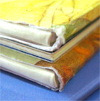|
|
|
|
|
|
|

| 최근 이 책을 구매하신 다른 회원의 책장 |
|
 |
|
|
|
[ 책 소개 ]
닥터 수스의 모자 쓴 고양이와 함께 우리 몸에 대해서 쉽고 재미있게 배울 수 있는 책입니다.
모자 쓴 고양이가 아이들을 데리고 우리 몸의 내부 모습을 보여주는 기계에 들어가서 신체 각 부분을 자세히 보여줍니다. 좌뇌와 우뇌, 피부와 골격, 관절, 척추, 5감 기관, 근육, 심장과 순환기관, 호흡기관, 소화기관, 간과 신장 등 우리 몸의 각 부분들이 어떤 일을 하는지를 사실적인 그림들과 간결한 문장으로 알기 쉽게 설명해 주는 책입니다.
튼튼한 | 닫기x |  What is 하드커버? What is 하드커버?
양장본이라고도 불리우며, 표지가 단단한 판지로 만들어진 책입니다.
판지를 천이나 가죽으로 감싸기도 합니다. 책의 속지는 일반적으로 중성처리된 종이(Acid-free paper)를 사용해서 잘 변질이 되지 않기 때문에 오랫동안 보관하기에 적합합니다. 이 종류의 책은 더스트 재킷, 또는 더스트 커버로 불리는 표지덮개가 함께 있는 경우가 많습니다. 간혹 내부 속지가 콩기름 코팅이 된 경우 고약한 냄새가 나는 책도 있습니다.
|
[ 서지 정보 ]
Hardcover: 48 pages
ISBN-10: 0375811001
ISBN-13: 978-0375811005
책 크기: 17 cm x 23.6 cm
[ 영문 서평 ]
Book Description
The Cat in the Hat takes Sally and Dick for a ride through the human body where they visit the right and left sides of the brain, meet the Feletons from far off Fadin (when they stand in the sun you can see through their skin), scuba dive through the blood system, follow food and water through the digestive tract, and a whole lot more!
School Library Journal
This installment in the series appears at first glance to be a useful overview of the human body. However, while the text flows in a pleasant Seuss-like way and the colorful artwork will please fans of The Cat in the Hat, some of the information is just plain wrong. For example, the statement that there are "soft bones in your nose" is incorrect; the nose is actually made up of cartilage. In another section, the text asserts that "in our stomachs there's food we ate three days ago." Food generally passes through the stomach in a matter of hours; it may take days to eliminate from the body, but the stomach empties relatively quickly. The heart is described as the biggest muscle in the body, but the gluteus maximus is actually the largest. For a better treatment of the subject for beginning readers, try Shelley Rotner and Stephen Calcagnino's The Body Book (Orchard, 2000) or Barbara Seuling's From Head to Toe (Holiday, 2002).
National Science Teachers Association Recommends
Young children will love Inside Your Outside! ...a good choice for teachers looking to integrate reading and science. |
|
|
|
|
|
|
|
|